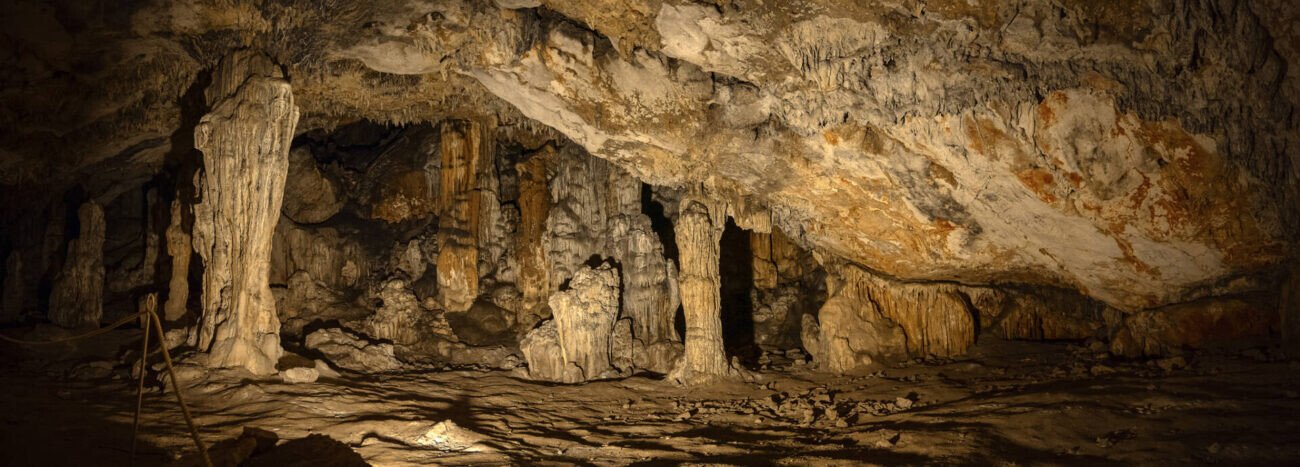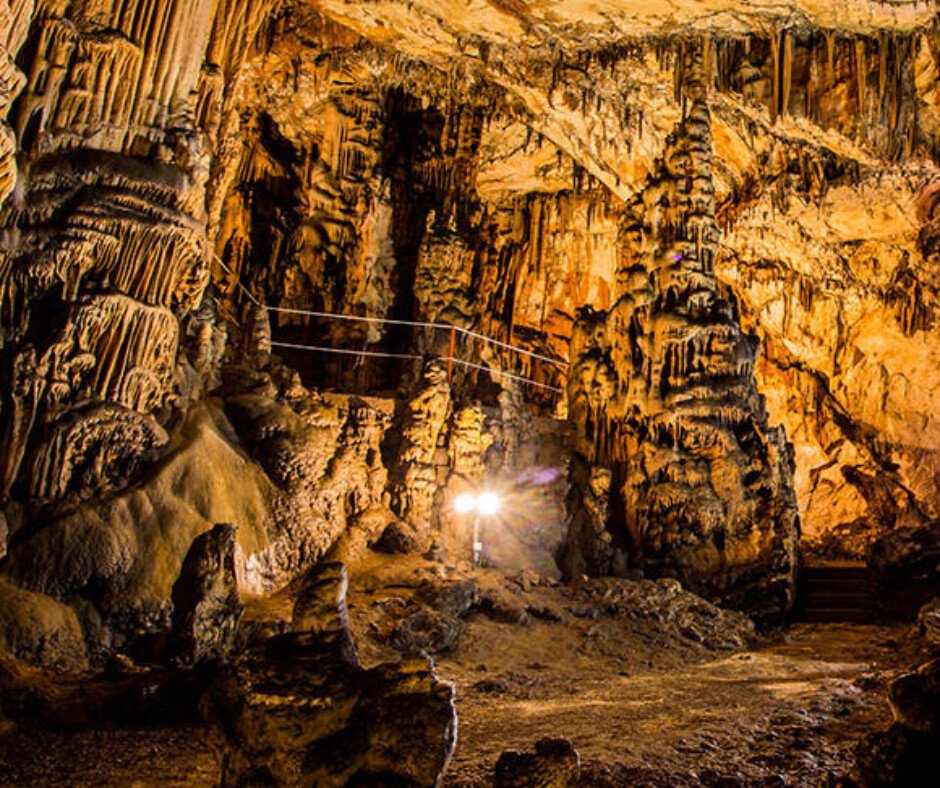What is happening down there? The world might seem bright and full of colour, but beneath our feet lies a vast universe of darkness and mystery. Croatia has an extensive network of caves across the country that are open to visitors, offering fascinating insights, awe-inspiring sights, and the perfect escape from the summer sun's heat. Plan carefully, as we are about to explore the country's subterranean wonderlands.
Baredine Cave, Istria
Istria’s first tourist-oriented speleological site, Baredine Cave has been welcoming visitors since 1995. The cave is just a few kilometres from the sea and provides all the magic and mystery of the underworld, with five rooms and several natural phenomena hidden within. The highlight might just be the 10-metre long “curtains,” strange, natural statues resembling everything from the Virgin Mary to the Leaning Tower of Pisa, not to mention a torch-bearing snowman. The cave is just a short drive from Poreč, and welcomes visitors every half hour or so from April to October.Pazin Cave, Istria
This isn’t your average cave. For one, it is only possible to visit Pazin Cave on pre-arranged tours, and you need a certain level of adventure (and physical fitness) to make the most of it. Don’t expect well-built pathways and special lighting here; this is cave exploring as it should be. Ziplines transfer explorers to magical underground lakes, and the sense of adventure here is positively exhilarating. The tour lasts two and a half hours, so be sure to wear appropriate clothing and footwear.Mramornica Cave, Istria
Way back in 1770, Italian writer and cartographer Alberto Fortis is said to have visited Mramornica Cave, although travellers today get to explore this Istrian delight in much more comfortable circumstances. One of the largest caves in Istria, Mramornica is packed with colourful dripstones and imposing stalagmites, and plenty of work has made its galleries accessible to visitors. The cave is located near the beautiful village of Brtonigla. Guided tours are available.Lokvarka Cave, Gorkski kotar
One of the most beautiful caves in Croatia, it is thought that Lokvarka was discovered by accident in 1991. What was supposed to be a relatively routine limestone excavation turned into a real discovery, and the cave was subsequently explored by geologist Josip Poljak. As much a cavern with multiple floors as a classic cave, Lokvarka is situated around 25km from Rijeka and open daily for visitors to come and admire the stalactites, stalagmites, and more.Vrelo Cave, Gorski kotar
Discovered in the 1950s when the Bajer reservoir was constructed, Vrelo Cave is small but perfectly formed. The cave only stretches some 300 metres, but what awaits is absolutely beautiful, its exquisite decorations accentuated by the abundance of mountain water found here. It is believed to be the only cave in Europe accessible to all (there are no steps inside), and tours last approximately 30 minutes. Large groups are advised to make a reservation in advance of their arrival.Biserujka, Krk Island
Located on Krk (Croatia’s biggest island), Bisreujka is a must for anyone interested in the wonderful world of the subterranean. You can be forgiven for missing the entrance, hidden behind another stone in the barren expanse, but there are secrets waiting here. The cave is packed with curiosities, not to mention six endemic species that give life to the darkness. The cave is located northwest of Rudine and is open from April to September; however, it is recommended to call ahead before visiting.Grapčeva Cave, Humac, Hvar Island
The Grapčeva Cave in Humac is shrouded in myth and mystery, but isn’t that exactly what we want from our subterranean wonderlands? It is believed that none other than Odysseus himself did battle with a cyclops here, and one visit to the cave reveals an ideal setting for a fantastical battle. The interior is all stalactites and stalagmites, and the extensive research done in these parts revealed a prehistoric civilisation active many millennia before the common era. Grapčeva is best explored on a private tour during the summer, an excursion covering Humac in greater detail. Contact the Mob: +385 99 577 17 70; humac.tour@gmail.com for more information.
The Dragon's Cave, Brač Island
A spectacular natural, cultural and spiritual monument, in the 15th century this cave was became a home and a place of worship complete with awe-inspiring reliefs carved into the rock.The steep south-facing karst hills close to Bol are pitted with caves which, in the Middle Ages, provided shelter for refugees from mainland convents and monasteries who fled from the invading Ottoman armies. Since these were eremitic orders living an ascetic life of solitary prayer, these isolated caves, apart from providing a safe hiding place, were a logical choice for habitation. However, the friars and nuns worked hard at making their abodes fitting places for service to God, and thus in this 20 metre long cave four halls were created that comprised a monastery and church. A chapel and an altar were carved into the rock, there are water cisterns, graves and niches for solitary prayer and the walls were decorated with fabulous carvings.
So bold, so powerful and well-executed are these carvings that they are clearly the work of a master stonemason. They depict scenes from the New Testament Book of Revelation, also known as the Apocalypse. The Apocalypse is an allegory of the struggle between good and evil played out by characters such as multi-headed beasts, a dragon representing Satan and the heroic Lamb. There are also carved symbols such as a pelican - a symbol of Christian self-sacrifice, as well as angels and lunar motifs drawing on Slav mythology. By portraying these scenes the sculptor spoke of the suffering of Christians throughout history with the benefit of ample personal experience.
Visiting this cave is a powerful experience. It’s a steep one-hour hike from Murvica, near Bol. You should allow four hours for the round trip, as there are abandoned chapels and monasteries along the way which are worth looking round. You need a sturdy pair of trainers, plenty of water and adequate sun protection in hot weather. An English- and German-speaking guide takes up groups once a day, since the walk is quite demanding. Guided visits are best arranged at least 24 hours in advance, and cost 6,64 € per person, or by agreement for groups. Call Zoran on 091 514 97 87.
Blue Cave, Biševo Island
Located on the Island of Biševo, the Blue Cave is an amazing natural phenomena. The interior of the cave and the sea below are a silver-blue colour. Rays of sun peak through a crack in the cave, which reflect into the sea and create beautiful light effects on top of the water. It’s only a 15 min drive by speedboat from Komiža, a coastal town on the western coast of the Island of Vis.Manita Cave, Paklenica National Park
Paklenica National Park has no shortage of underground attractions, but few can match Manita Cave for popularity and excitement. The cave has been open to visitors since 1937, drawing adventurers who seek to explore the intriguing subterranean structures and mysterious formations hidden within. Manita is also strangely rich in underground life, with around 52 different types of invertebrates making a life down here in the darkness. Tours of the cave last around half an hour, but give yourself plenty of time to walk here from the main entrance of the park.Samograd Cave, Cave Park Grabovača
Lovers of magical natural creations will find plenty to admire at the Samograd Cave. A guided tour of the cave takes visitors on a journey through time, telling of the cave’s development over millions of years and the weird and wonderful formations found within. You’ll also get plenty of information about nearby Perušić, making this a proper two-for-one adventure. The cave is open every day from April until November, and groups of 10 or more must make a booking in advance.Vranjača Cave, Dugopolje
The Vranjača cave is made up of two chambers. The first, the existence of which was already known in the 19th century, has no stalactites. The second was discovered in 1903 by Stipe Punda, who was the owner of this plot of land. This part consists of a system of nine smaller chambers in colours ranging from green through blue, some of which shimmer due to the presence of crystals. The cave is about 360m long and is at a constant temperature of 15ºC all year round. Vranjača is suitable for visits by tourists, with steps, rope handrails, walkways and lighting. It is supervised and has a car park. The cave is well visited by day trippers from Split and nature lovers from all over.The cave, Vranjača, is located in the foothills of the central part of Mosor, on the northern side. If you are coming from Split then take the paved road through Dugopolje to the village Kotlenica in the hamlet Punde (25km) and finally follow another 300m path to the entrance of the cave. The cave is open 09:00 - 20:00 (June, July, August), 09:00 - 19:00 (May, September), 10:00 - 18:00 (April, October) and by prior arrangement (November - March). Guided tours, which last about 1 hour, are available in English, and cost 8€ for adults and 4€ for children. Please call (+385-) 098 74 90 00 for more information.






Comments